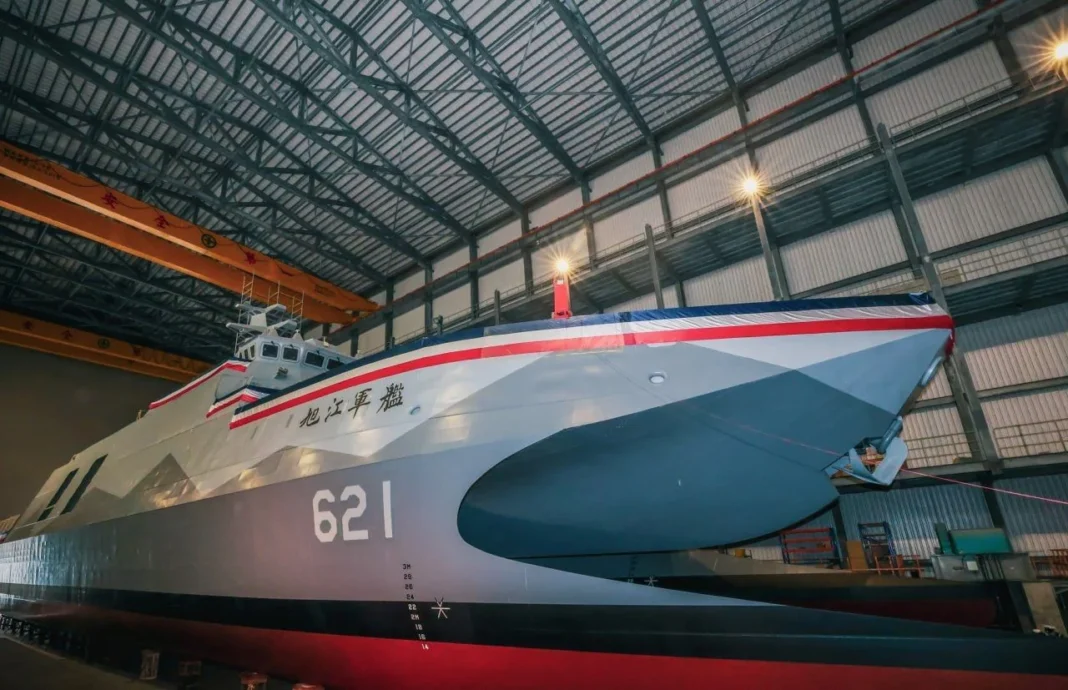The Republic of China Navy (RoCN, or the Taiwanese Navy) launched a unique missile corvette, Xujiang, which is meant to deter Chinese warships and aircraft with its anti-ship, air defense, and Gatling gun-based close-in weapons systems (CIWS).
The Xujiang is the fourth in the series of Tuo Chiang-class boats, which began launching last year. The lead ship was delivered to the RoCN in March 2014, the second vessel, Ta Chiang, was commissioned in 2021, while the Fu Jiang was launched on September 21, 2022.
The same year, Taiwan’s Ministry of National Defense (MoND) announced ten additional such ships, taking their total number to 14.
Taiwan off-late has been staring at the increasing possibility of a Chinese military takeover with warplanes repeatedly flying into its air defense identification zone (ADIZ) since former US Speaker Nancy Pelosi’s visit to the island in August 2022.
While Chinese military flights into RoC ADIZ have been a standard feature for the past several years, they have been more specific and targeted, clearly suggesting the Chinese are minutely working out their attack plans.
China Means Business
The drills around Taiwan immediately after the Pelosi visits themselves were unprecedented. They were the first-of-their-kind live-fire exercises; involved firing missiles over Taiwanese skies; were held simultaneously at six locations around Taiwan; and saw the full operational use of highly advanced platforms like the J-20 stealth fighter.
The surrounding geopolitics, too, from China’s perspective, has been hostile. An increasingly hardline Japan and NATO’s bonhomie with Taiwan, with American blessings, has hardened perceptions of an anti-China military alliance aimed at the Communist Party of China (CPC).
As part of Washington’s rising strategic confrontation with Moscow and Beijing, many Western experts note how China would now unflinchingly resort to military force if diplomacy, or its peaceful reunification doctrine with Taiwan, fails.
China’s red lines over Taiwan are considered the island declaring independence, a major country or a group of nations recognizing it as an independent nation, or Taiwan being armed with major strategic weapons.
The Tuo Chiang class boats are equipped with Hsiung Feng III (HF-3) anti-ship missiles, Sea Sword air defense systems, a Phalanx close-in weapon system, and 76-millimeter guns rapid-fire guns on the bow.
The corvettes reportedly have a maximum speed of 40 knots (74 kilometers/46 miles per hour) and a range of up to 1,800 nautical miles (3,333 kilometers/2,071 miles). The ten additional Tuo Chiangs are set to be built between 2022 and 2026.
The purpose behind the Tuo Chiang is to practice sea denial by undertaking independent anti-ship operations against the more vast and technologically advanced People’s Liberation Army Navy (PLAN), either through solitary missions or part of small, agile wolfpacks. Taiwan admittedly has no means of controlling and holding its seas.
Thus, relying on such fast, elegant, and readily dispersible vessels hidden in caves, small ports, or shelters around the island’s rough coasts is within its modest means to hold off, if not beat back, a Chinese naval armada.
Corvettes No Magic Wand
The Tuo Chiang boats, although hydrodynamically robust and suited for the rough seas of the Taiwan Straits, do not have the radar, sensor, and payload capability against a massive PLAN flotilla.
These would comprise aircraft carriers like the Liaoning and the Shandong and sophisticated warships like the Type-055, Type-052C, and Type-052D.
Its Oliver Hazard Perry-class frigates or the Kidd-class destroyers might provide long-range surveillance for the Tuo Chiang. But how long these would last in a saturated anti-access/area-denial (A2/AD) environment with a combined arms strike and China sending its own small attack boats and specialized catamarans to hit Tuo Chiang is doubtful.
To protect themselves from A2/AD missiles, these Taiwanese ships may be forced to retreat to the safer coastline and be relegated to coastal defense, taking away even the limited sea denial capability. This way, they become an even easier target for air and sea-launched surface strike and anti-ship missiles.
To complicate the Taiwanese naval and land-based missile shield, China would combine amphibious naval strikes and aerial attacks to force the defenders to exhaust their ammunition.
Chinese missile strikes will initially target Taiwan’s land-based Patriots and Sky Bow surface-to-air missiles. Their positions can be identified by the long-range high-altitude WZ-7 Soaring Dragon or the BZK-005 intelligence-surveillance-reconnaissance (ISR) drones.
China’s legacy jets-turned-drones like the Q-5, J-6, or J-7 can likely bait its air defenses into revealing their positions and cue anti-radiation and land attack missiles from Chinese warships, H-6 bombers or Su-30MKK fighter-bombers.
Military Balance In China’s Favor
Put differently, the Communist People’s Republic of China (PRC) will not use warships alone to take Taiwan. Naval vessels will be used alongside hundreds of aircraft (fighters, bombers); drones; attack helicopters; a dozen submarines; long-range anti-land and anti-ship missiles; hundreds of tanks and infantry fighting vehicles carrying thousands of troops being transported by tens of civilian vessels, and several hundred civilian militias consisting of fishing vessels.
These will be supported by an array of satellites, reconnaissance aircraft, and land-based infrastructure that Taiwan does not have. A large landmass that provides ‘strategic depth’ to prepare, manufacture, industrialize, and aid the logistics for war is a great asset, which the island lacks.
Moreover, as noted by previous EurAsian Times analyses, studies by China hawkish think tanks have not predicted favorable ends for Taiwan and the US. Pentagon-commissioned wargames by RAND have ended in devastating US and Taiwanese defeats before swarms of thousand of Chinese ships, planes, missiles, and drones.
An extensive wargame by CSIS in January culminated in horrific losses for China, the US, and Taiwan. This is a favorable outcome for Beijing since it prevents Washington and Taipei from achieving their military objective of deterring a military strike from the mainland.
Taiwan’s own conventionally shaped military cannot deal with asymmetric Chinese weapons like a mass drone, ship, and missile attacks.
Its only credible military plan, the Overall Defense Concept, which envisages non-legacy platforms, has been reported by Western experts to be running into internal resistance. The military balance in the Taiwan Straits is heavily skewed in the PRC’s favor, and the Tuo Chiang corvettes do little to alter that.
eurasiantimes

